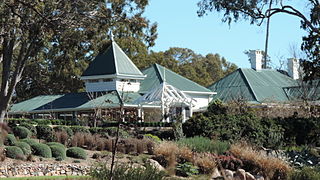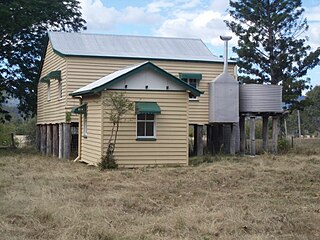Related Research Articles
A pastoral lease, sometimes called a pastoral run, is an arrangement used in both Australia and New Zealand where government-owned Crown land is leased out to graziers for the purpose of livestock grazing on rangelands.

Sir John Robertson was a London-born Australian politician and Premier of New South Wales on five occasions. Robertson is best remembered for land reform and in particular the Robertson Land Acts of 1861, which sought to open up the selection of Crown land and break the monopoly of the squatters.
The Crown Lands Acts 1861 (NSW) (or Robertson Land Acts) were introduced by the New South Wales Premier, John Robertson, in 1861 to reform land holdings in New South Wales and in particular to break the squattocracy's domination of land tenure. The Acts allowed free selection of crown land and made redundant the limits of location, which limited sale of land to the Nineteen Counties which had applied since 1826.

The Native Title Act 1993(Cth) is a law passed by the Australian Parliament, the purpose of which is "to provide a national system for the recognition and protection of native title and for its co-existence with the national land management system". The Act was passed by the Keating government following the High Court's decision in Mabo v Queensland (No 2) (1992). The Act commenced operation on 1 January 1994.

Rankins Springs is a village in the Riverina region of New South Wales, Australia in Carrathool Shire and on the Mid-Western Highway. At the 2011 census, Rankins Springs had a population of 299 residents living in 145 private dwellings. This dropped to 174 in 2016, but rebounded to 208 in 2021. The settlement is strung out along the Mid-Western Highway and adjacent railway line. The main agricultural activities of the district around Rankins Springs are the growing of crops such as wheat and oats, and beef-cattle.

In the history of Australia, squatting was the act of extrajudicially occupying tracts of Crown land, typically to graze livestock. Though most squatters initially held no legal rights to the land they occupied, the majority were gradually recognised by successive colonial authorities as the legitimate owners of the land due to being among the first white settlers in their area. The term squattocracy, a play on aristocracy, was coined to refer to squatters as a social class and the immense sociopolitical power they possessed.

Soldier settlement was the settlement of land throughout parts of Australia by returning discharged soldiers under soldier settlement schemes administered by state governments after World War I and World War II. The post-World War II settlements were co-ordinated by the Commonwealth Soldier Settlement Commission.

A homestead is an isolated dwelling, especially a farmhouse, and adjacent outbuildings, typically on a large agricultural holding such as a ranch or station.
Cuppacumbalong is an historic homestead located near the southern outskirts of Canberra in the Australian Capital Territory. It is also the name of a former 4,000-acre (16 km2) sheep and cattle grazing property that surrounded the homestead near the junction of the Murrumbidgee and Gudgenby Rivers. The word Cuppacumbalong is Aboriginal in origin and means 'meeting of the waters'. One of the property's early owners Leopold Fane De Salis made a noteworthy contribution to political life during colonial times and furthermore, Cuppacumbalong has strong connections to the life of William Farrer, the father of the Australian wheat industry.
Lemontree is a rural locality in the Toowoomba Region, Queensland, Australia. In the 2021 census, Lemontree had a population of 27 people.

Fassifern Homestead is a heritage-listed homestead at 1008B Boonah-Fassifern Road, Kalbar, Scenic Rim Region, Queensland, Australia. It was built circa 1880. It was added to the Queensland Heritage Register on 13 November 2008.

Peter Fitzallan MacDonald was a Member of the Queensland Legislative Assembly.

Braeside Homestead is a heritage-listed homestead at Crystal Mount Road, Dalveen, Southern Downs Region, Queensland, Australia. It was built from 1870s to 1920s. It was added to the Queensland Heritage Register on 23 August 2002.

Monsildale Homestead is a heritage-listed homestead at 2532 Monsildale Road, Monsildale, Somerset Region, Queensland, Australia. It was added to the Queensland Heritage Register on 3 April 2009.

The Selector's Hut is a heritage-listed hut at 20 Upper Camp Mountain Road, Camp Mountain, City of Moreton Bay, Queensland, Australia. It is also known as Marks' Hut. It was built c. 1870 by George Atthow. It was added to the Queensland Heritage Register on 3 December 2007.

Soldier Settler House is a heritage-listed homestead at Gladstone-Monto Road, Ubobo, Gladstone Region, Queensland, Australia. It was built in 1920. It is also known as Hecstanvale. It was added to the Queensland Heritage Register on 28 September 2001.
The Strangways Land Act, Strangways Act or Waste Lands Amendment Act, were common names for legislation enacted in January 1869 in the colony of South Australia, formally titled An Act to further amend the "Waste Lands Act" 1869. The Act enabled the purchase of land for farmers, allowing for closer settlement in areas of the province suited to more intensive agriculture, rather than vast pastoral runs on uncleared land leased from the government. It is named for Henry Strangways, who was premier and attorney-general when the legislation was passed, and had previously been the Minister for Crown Lands.

Gunnawarra Homestead is a heritage-listed homestead at Gunnawarra Road, Gunnawarra, Tablelands Region, Queensland, Australia. It was built from 1878 to 1908. It was added to the Queensland Heritage Register on 21 October 1992.

The process of land selectionin Queensland in Australia began in 1860. It continued under a series of land acts in subsequent years. When Britain claimed possession of Australia, it did so based on terra nullius and did not acknowledge that Indigenous people had any ownership over the land. All land in Australia became Crown land and was sold or leased by the Australian colonial governments according to the needs of the colonists.
There are two state-controlled roads linking Millmerran and Cecil Plains in the Toowoomba region of Queensland, Australia. They are Millmerran–Cecil Plains Road, which runs to the west of the Condamine River, and Pampas–Horrane Road, which runs east of the river.
References
- 1 2 Pearl, Cyril (1958). Wild Men of Sydney. London: W.H. Allen. p. 177. ISBN 0-207-13539-8.
- ↑ Roberts, Stephen H., History of Australian Land Settlement, 1788-1920, Macmillan / Melbourne University Press, Melbourne, 1924.
- ↑ Kerr, Ruth (3 April 2018). "Part 1: A Brief History of land selection – Stories from the Archives". Queensland State Archives. Archived from the original on 11 May 2020. Retrieved 11 May 2020.
- ↑ Jaensch, Dean. "Strangways, Henry Bull Templar (1832 - 1920)". Australian Dictionary of Biography . Canberra: National Centre of Biography, Australian National University. ISBN 978-0-522-84459-7. ISSN 1833-7538. OCLC 70677943 . Retrieved 22 May 2007.
- ↑ Year Book Australia, 1911, LAND TENURE AND SETTLEMENT
- ↑ Duffy's Act 1862
- ↑ The Land and Pastoral Acts 1869
- ↑ "Land". Public Record Office Victoria . Retrieved 19 August 2016.